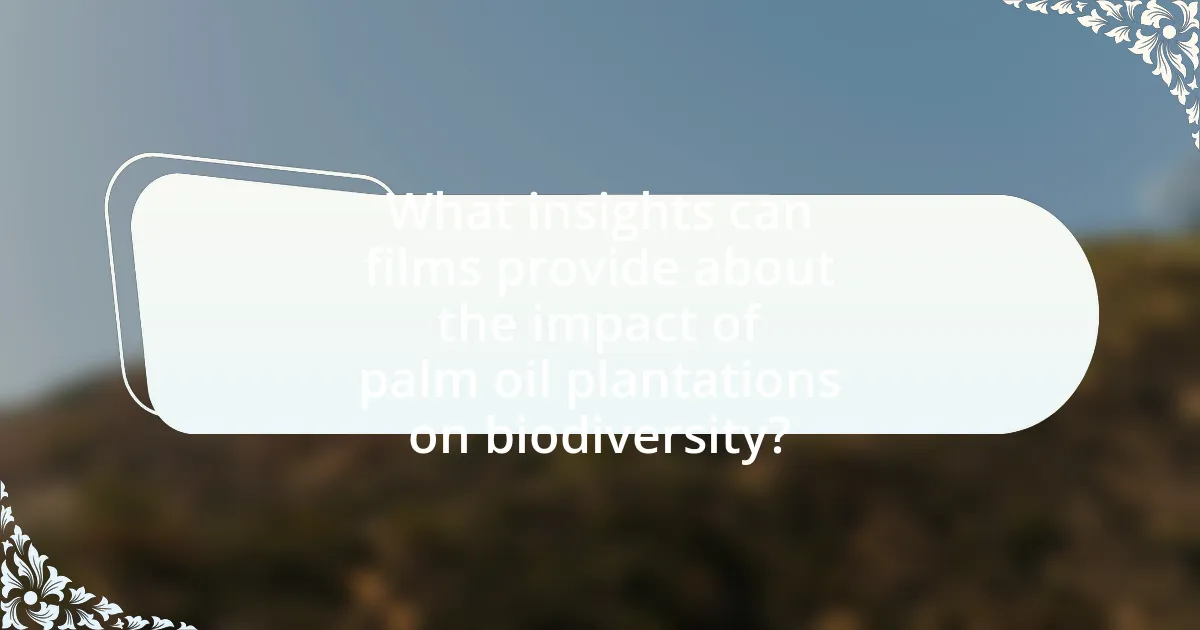Palm oil plantations have a profound impact on local biodiversity, primarily through habitat destruction and the establishment of monocultures, which lead to significant declines in species richness. This article examines the effects of palm oil cultivation on ecosystems, highlighting the endangerment of species such as orangutans and tigers, and discusses the role of biodiversity in maintaining ecosystem health. It also explores how films and documentaries raise awareness about these issues, illustrating the environmental consequences of palm oil production and advocating for sustainable practices. Additionally, the article outlines potential solutions to mitigate biodiversity loss, including sustainable agricultural practices and consumer actions that support biodiversity-friendly palm oil.

How do palm oil plantations impact local biodiversity?
Palm oil plantations significantly reduce local biodiversity by replacing diverse ecosystems with monocultures. This transformation leads to habitat loss for numerous species, including endangered animals such as orangutans and tigers, which rely on complex forest environments for survival. Research indicates that deforestation for palm oil cultivation has resulted in a decline of up to 50% in species richness in affected areas, as reported by the International Union for Conservation of Nature. Additionally, the use of pesticides and fertilizers in these plantations further disrupts local ecosystems, harming non-target species and reducing overall ecological resilience.
What are the primary effects of palm oil plantations on ecosystems?
Palm oil plantations primarily lead to habitat destruction, loss of biodiversity, and soil degradation. The establishment of these plantations often involves clearing large areas of tropical forests, which results in the displacement of numerous species and a significant decline in local biodiversity. For instance, studies indicate that palm oil expansion has contributed to the endangerment of species such as orangutans and tigers, as their natural habitats are destroyed. Additionally, the monoculture practices associated with palm oil cultivation can lead to soil erosion and nutrient depletion, further harming the ecosystem’s health.
How do palm oil plantations alter habitats for local species?
Palm oil plantations significantly alter habitats for local species by replacing diverse ecosystems with monocultures. This transformation leads to habitat loss, fragmentation, and a decline in biodiversity, as many species are unable to adapt to the altered environment. For instance, studies indicate that the conversion of tropical forests to palm oil plantations can result in a 50% reduction in species richness, particularly affecting mammals, birds, and insects that rely on complex forest structures for survival. Additionally, the use of pesticides and fertilizers in these plantations further degrades the surrounding environment, impacting water quality and soil health, which in turn affects local wildlife.
What species are most affected by palm oil cultivation?
The species most affected by palm oil cultivation include orangutans, tigers, elephants, and various bird species. These animals face habitat loss due to deforestation and land conversion for palm oil plantations. For instance, the Sumatran orangutan population has declined by over 50% in the last 20 years, primarily due to habitat destruction linked to palm oil expansion. Additionally, the critically endangered Sumatran tiger is threatened as its forest habitat is cleared for palm oil production, leading to increased human-wildlife conflict. The loss of biodiversity in these regions is significant, with many species facing extinction as their natural habitats are replaced by monoculture plantations.
Why is biodiversity important in the context of palm oil plantations?
Biodiversity is crucial in the context of palm oil plantations because it enhances ecosystem resilience, supports food security, and maintains ecological balance. Diverse ecosystems provide essential services such as pollination, pest control, and nutrient cycling, which are vital for the productivity of palm oil crops. Studies indicate that plantations with higher biodiversity levels can yield better agricultural outcomes; for instance, research published in “Biodiversity and Conservation” shows that integrating native species into palm oil landscapes can increase crop yields by up to 30%. Furthermore, preserving biodiversity helps mitigate the negative environmental impacts of monoculture practices, such as soil degradation and increased vulnerability to pests and diseases.
What role does biodiversity play in ecosystem health?
Biodiversity is crucial for ecosystem health as it enhances resilience, productivity, and stability. Diverse ecosystems can better withstand environmental stressors, such as climate change and disease, due to the variety of species fulfilling different ecological roles. For instance, a study published in the journal “Nature” found that ecosystems with higher species diversity are more productive and can recover more quickly from disturbances. This relationship underscores the importance of maintaining biodiversity to ensure the sustainability and functionality of ecosystems.
How does the loss of biodiversity affect local communities?
The loss of biodiversity negatively impacts local communities by diminishing ecosystem services essential for their livelihoods. These services include food production, clean water supply, and natural pest control, which are vital for agricultural sustainability. For instance, a study published in the journal “Nature” found that regions with higher biodiversity have more resilient agricultural systems, leading to increased crop yields and food security. Additionally, the decline in biodiversity can lead to increased vulnerability to climate change, as diverse ecosystems are better equipped to adapt to environmental shifts. This loss can also disrupt cultural practices and traditional knowledge tied to local flora and fauna, further eroding community identity and resilience.

What insights can films provide about the impact of palm oil plantations on biodiversity?
Films can provide critical insights into the impact of palm oil plantations on biodiversity by visually illustrating the destruction of habitats and the decline of species. Documentaries such as “Before the Flood” and “The True Cost” highlight the deforestation caused by palm oil cultivation, showcasing statistics that indicate over 50% of the original rainforest in Indonesia has been lost, leading to significant biodiversity loss. These films often feature interviews with environmentalists and indigenous communities, emphasizing the direct correlation between palm oil production and the endangerment of species like orangutans and tigers. By presenting these narratives, films effectively raise awareness and foster a deeper understanding of the ecological consequences associated with palm oil plantations.
How do documentaries portray the effects of palm oil on local ecosystems?
Documentaries portray the effects of palm oil on local ecosystems by highlighting deforestation, loss of biodiversity, and habitat destruction. For instance, films often depict the conversion of rainforests into palm oil plantations, which leads to the displacement of wildlife and the endangerment of species such as orangutans and tigers. Specific examples include the documentary “Before the Flood,” which illustrates how palm oil production contributes to climate change and disrupts local habitats. Additionally, these films frequently present statistics, such as the fact that palm oil plantations have been linked to a 50% decline in certain animal populations in affected areas, emphasizing the urgent need for sustainable practices.
What specific examples from films illustrate biodiversity loss due to palm oil?
Films such as “Racing Extinction” and “Before the Flood” illustrate biodiversity loss due to palm oil by showcasing the destruction of rainforests and the resulting habitat loss for endangered species. In “Racing Extinction,” filmmakers document the impact of palm oil plantations on orangutan populations, highlighting how deforestation for palm oil cultivation leads to the decline of these primates. Similarly, “Before the Flood” features scenes that depict the conversion of biodiverse ecosystems into monoculture plantations, emphasizing the negative effects on wildlife and plant species. These films provide visual evidence of the environmental consequences of palm oil production, reinforcing the urgent need for sustainable practices.
How do filmmakers convey the emotional and ecological narratives surrounding palm oil?
Filmmakers convey emotional and ecological narratives surrounding palm oil through visual storytelling, personal testimonies, and impactful imagery that highlight the consequences of palm oil production. Documentaries like “Before the Flood” and “The True Cost” illustrate the environmental degradation caused by deforestation for palm oil plantations, showcasing the loss of biodiversity and its effects on local communities. These films often include interviews with affected individuals, emphasizing their emotional struggles and the cultural significance of their land, which reinforces the urgency of the ecological crisis. By combining personal stories with factual data, filmmakers effectively raise awareness and provoke emotional responses, driving home the importance of sustainable practices in palm oil production.
What messages do films aim to communicate regarding palm oil and biodiversity?
Films aim to communicate the detrimental impact of palm oil plantations on biodiversity. They often depict the destruction of habitats, leading to the endangerment of species such as orangutans and tigers, which are directly affected by deforestation for palm oil cultivation. Documentaries like “Before the Flood” and “Our Planet” highlight the urgent need for sustainable practices and the consequences of consumer choices on ecosystems. These films serve to raise awareness and encourage viewers to consider the environmental implications of palm oil production, emphasizing the importance of biodiversity conservation in the face of industrial agriculture.
How do films influence public perception and awareness of palm oil issues?
Films significantly influence public perception and awareness of palm oil issues by visually depicting the environmental and social impacts of palm oil plantations. Through storytelling and emotional engagement, films can highlight the destruction of biodiversity, such as the loss of habitats for endangered species like orangutans, and the displacement of indigenous communities. For instance, documentaries like “Before the Flood” and “The True Cost” have raised awareness about the unsustainable practices associated with palm oil production, leading to increased public discourse and advocacy for sustainable alternatives. This visual medium effectively communicates complex issues, making them accessible and relatable, thereby motivating viewers to take action or change their consumption habits.
What actions do films encourage viewers to take regarding palm oil consumption?
Films encourage viewers to reduce their palm oil consumption by promoting awareness of its environmental impact and advocating for sustainable alternatives. Documentaries and narratives often highlight the destruction of biodiversity caused by palm oil plantations, urging audiences to choose products that are certified sustainable or free from palm oil. For instance, films like “Before the Flood” and “Our Planet” illustrate the consequences of deforestation and habitat loss, motivating viewers to support brands that prioritize ethical sourcing. This approach is supported by research indicating that consumer choices can significantly influence market demand for sustainable products, thereby encouraging companies to adopt environmentally friendly practices.

What are the potential solutions to mitigate the impact of palm oil plantations on biodiversity?
To mitigate the impact of palm oil plantations on biodiversity, implementing sustainable agricultural practices is essential. These practices include agroforestry, which integrates trees and shrubs into palm oil cultivation, enhancing habitat complexity and supporting wildlife. Additionally, establishing protected areas around plantations can preserve critical ecosystems and provide refuge for native species. Certification schemes, such as the Roundtable on Sustainable Palm Oil (RSPO), promote environmentally friendly practices and ensure that palm oil is sourced responsibly, reducing deforestation and habitat loss. Research indicates that certified sustainable palm oil can lead to a 30% reduction in deforestation rates compared to conventional practices, highlighting the effectiveness of these solutions.
How can sustainable palm oil practices help preserve biodiversity?
Sustainable palm oil practices can help preserve biodiversity by minimizing habitat destruction and promoting ecological balance. These practices include maintaining buffer zones around plantations, implementing agroforestry systems, and adhering to certification standards like the Roundtable on Sustainable Palm Oil (RSPO). For instance, RSPO-certified plantations are required to protect high conservation value areas, which are crucial for maintaining diverse ecosystems. Research indicates that sustainable practices can reduce deforestation rates by up to 50%, thereby protecting the habitats of numerous species. Additionally, integrating sustainable methods can enhance soil health and water quality, further supporting local biodiversity.
What certifications exist for sustainable palm oil production?
The main certifications for sustainable palm oil production are the Roundtable on Sustainable Palm Oil (RSPO), the International Sustainability and Carbon Certification (ISCC), and the Rainforest Alliance certification. RSPO, established in 2004, sets criteria for sustainable palm oil production, focusing on environmental and social impacts. ISCC provides a certification system for sustainable biomass and bioenergy, ensuring traceability and compliance with sustainability criteria. The Rainforest Alliance certification emphasizes biodiversity conservation and sustainable land management practices. These certifications are recognized globally and aim to promote responsible palm oil production while addressing environmental concerns.
How do these practices benefit local ecosystems and communities?
Sustainable palm oil practices benefit local ecosystems and communities by promoting biodiversity conservation and enhancing local livelihoods. These practices, such as agroforestry and reduced chemical use, help maintain habitat for various species, thereby preserving ecological balance. For instance, studies have shown that integrating palm oil cultivation with native vegetation can increase species richness by up to 30%. Additionally, these practices provide economic opportunities for local communities through sustainable farming techniques, which can lead to improved food security and income stability.
What role can consumers play in supporting biodiversity-friendly palm oil practices?
Consumers can support biodiversity-friendly palm oil practices by choosing products certified by recognized sustainability standards, such as the Roundtable on Sustainable Palm Oil (RSPO). By purchasing these certified products, consumers drive demand for palm oil that is produced with minimal environmental impact, thereby encouraging companies to adopt sustainable practices. Research indicates that the RSPO certification helps reduce deforestation and habitat destruction associated with palm oil production, as it requires adherence to specific environmental and social criteria. Thus, consumer choices directly influence the market and promote biodiversity conservation in palm oil-producing regions.
How can consumers identify and choose sustainable palm oil products?
Consumers can identify and choose sustainable palm oil products by looking for certifications such as the Roundtable on Sustainable Palm Oil (RSPO) label, which ensures that the palm oil is produced in an environmentally and socially responsible manner. Additionally, consumers should research brands that commit to sustainable sourcing practices and transparency in their supply chains. According to the RSPO, certified palm oil must meet specific criteria that protect biodiversity, reduce greenhouse gas emissions, and respect the rights of local communities. By prioritizing products with these certifications and supporting companies that demonstrate a commitment to sustainability, consumers can make informed choices that contribute to the preservation of local biodiversity affected by palm oil plantations.
What are the best practices for reducing palm oil consumption while supporting biodiversity?
The best practices for reducing palm oil consumption while supporting biodiversity include promoting sustainable alternatives, advocating for certified sustainable palm oil, and encouraging consumer awareness. Sustainable alternatives, such as using oils like sunflower or rapeseed, can help decrease reliance on palm oil. Certified sustainable palm oil, which adheres to standards set by organizations like the Roundtable on Sustainable Palm Oil (RSPO), ensures that production methods minimize environmental impact and protect biodiversity. Additionally, raising consumer awareness about the ecological consequences of palm oil can drive demand for sustainable products, leading to more responsible sourcing practices. These strategies collectively contribute to the reduction of palm oil consumption while fostering biodiversity conservation.

Leave a Reply